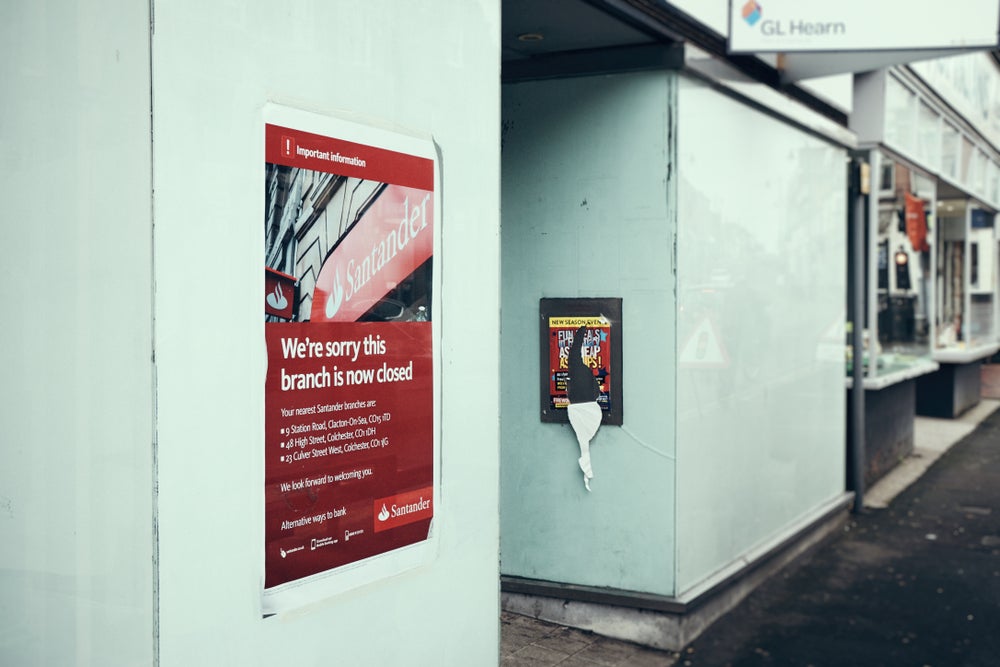As branch numbers decrease and internet banking figures continue to soar, what does the future hold for branch banking? Isabella Grotto takes a look at global branch innovation in 2013, and the opportunities that the ‘branches of the future’ hold for financial institutions in the digital age
It is no secret that online banking, mobile apps and digital channels have been taking the banking world by storm, as banks all over the world race to keep up with consumers’ digital demands. At the same time, figures increasingly prove that often the rise of digital has been accompanied by a steady decline in branch banking.
A 2013 report by consulting service Capgemini, titled ‘The Future of Bank Branches: Coordinating Physical with Digital’, reveals branch numbers in the US fell by 3,000 (3%) between 2009 and 2012.
The financial crisis has certainly played a significant role in encouraging bank closures, particularly among those countries which were affected the most. Spain, first in Europe for branch numbers per capita, has seen 5,000 (12%) of its bank branches close since 2008, and yet the recession alone is unlikely to be able account for this shift.
Rather, the general consensus sees a massive shift in customer behaviour, and the consequent failure by banks to meet these expectations, as a determining factor in the decline of the traditional branch.
Changing expectations
How well do you really know your competitors?
Access the most comprehensive Company Profiles on the market, powered by GlobalData. Save hours of research. Gain competitive edge.

Thank you!
Your download email will arrive shortly
Not ready to buy yet? Download a free sample
We are confident about the unique quality of our Company Profiles. However, we want you to make the most beneficial decision for your business, so we offer a free sample that you can download by submitting the below form
By GlobalDataFor one, soaring appreciation of online banking among consumers has certainly helped reinforce the idea that bank branches, at least in the way we think of them, will soon be a thing of the past. Indeed, Capgemini’s report finds the percentage of bank customers who prefer online banking to have almost doubled, increasing from 36% to 62%.
It is also important to note that while customers are increasingly choosing digital banking to carry out most day-to-day transactions, this is not to say they do not expect their bank to hold branches, nor wish to carry out more complex transactions through them.
A study into ‘Banking in the Digital Era’, published in November 2013 by multinational consulting group Accenture, sees today’s relationship between banks and their customers as ‘tenuous’, trapped in the conundrum of a customer base increasingly focused on online platforms, yet still attached to branch interaction.
Mike Goodson, managing director and head of management for Accenture’s North America banking division, commented on the figures: "There is little question that branches remain important in the minds of US consumers today, they are cited as the number one reason for loyalty, and eight out of ten consumers see themselves using branches as often or more often in five years’ time.
"But this is changing quickly, as profitability pressures motivate banks to promote less costly and more convenient ways of banking to customers," he explained.
Capgemini confirm the trend, revealing that in the post-financial crisis era, the mere physical presence of physical branches is of great importance to customers. According to their report, as many as 47% of US banking customers believe a bank is not legitimate unless it has branches, up from 41% in 2012.
Their research also reported that ‘90% of consumers prefer face-to-face advice for complex products’, with branches remaining the most widely preferred channel for both applying for loans (53%) and obtaining support from a banking representative (48%), see Table 1.
Branch banking remains an all-important point of contact between consumers and their banks, but delivery systems must be updated if they are to make the most of their branch network.
In this tension between new technological possibilites and increasingly sophisticated customer demands, is where the digital branches of the future fit. Rather than competing with online systems, branches should evolve to support a multi-channel banking experience, where they will continue to enable banks to build and improve customer relationships.
"The banking industry is currently at the inflection point the retail industry was about a decade ago", states Capgemini’s report, and banks will have to learn to adapt if they want to avoid the fate of retailers, such as film and game rental company Blockbuster or music giant HMV, who failed to evolve a competitive response to the high-street’s increasing demand for digital service.
Further, just as a purely brick-and-mortar model is outdated, so a purely online base is insufficient to address all of consumers’ needs, as retailers such as eBay and Dell discovered, and banks must take this lesson of ‘online-offline coordination’ on board if they wish to attract and retain customers.
Digital branches offer a way out of the expenses traditionally associated with highly staffed, brick-and-mortar, high-street located branches.
Another advantage of the so-called ‘online-offline model’ is its ability to leverage a whole suite of channels to cater to the full range of customer segments, from mass retail to affluent.
By differentiating the experience for clients, either through different technological provisions within one bank, or through several digital branches aimed at different segments, banks can ensure customers feel valued by the bank as they receive personalised attention, information they want and require, as well as quick and expert service.
‘While this transformation will not occur overnight and branches will not disappear, banks need to start rethinking the role of the physical bank branch and how it blends with the digital channels,’ concludes Capgemini.
Digital branch models and pioneers
Some banks have already established their presence in the digital bank branch arena.
Canadian Imperial Bank of Commerce (CIBC)
Notable examples include the Canadian Imperial Bank of Commerce (CIBC), whose flagship digital branch opened almost exactly a year ago in Courtice, Canada.
CIBC’s ‘branch of the future’ has customers, and their experience, at its heart. Combining a high-impact street presence with a high-tech open-concept interior, the branch features tablets and laptops for client use, a multi-functional lounge and seminar space, and digital displays replacing posters.
The bank’s aim through its digital branch were to strengthen client engagement and access, create in-branch sales opportunities, increase ease of transactions and promote the CIBC brand.
Jyske Bank
Across the water, another player making headway in digital branch banking is Danish bank Jyske, a veteran of the digital branch model. Headquartered in Silkeborg and counting 125 branches throughout the country, the bank first deployed its ‘digital signage’ strategy in 2006.
The majority of Jyske bank’s branches take on what analysts analysts at Capgemini have termed a ‘Shop’ model.
The first of four models identified by the consultancy as possible present and future configurations of the digital branch, the Shop model relies on retail-inspired displays to help customers browse self-service aisles independently.
According to Capgemini’s report, Jyske’s new digital branch model adoption resulted in tangible success, with the bank doubling its acquisition rate to 8,000 new customers in 6 months.
Well-grounded in its similarity to existing retail configurations, the Shop model differs significantly from the others outlined by Capgemini.
Another, widely employed model for digital branches is the ‘Lounge’ model. Focusing on customer relationship creation in a comfortable, somewhat intimate environment, the aim of Lounge-model digital branches lies not it selling, but in cultivating existing customer relationships ‘for cross-selling and up-selling services’, according to Capgemini.
Virgin Money
A widely publicised example of Lounge-style branch banking can be found in UK-based Virgin Money’s Virgin Money Lounges.
Available to Virgin banking customers upon registration and the receipt of a membership card, the lounges offer complementary services including refreshments, internet access through iPads, TVs, business meeting areas and lounges which can be lent for community events.
Also provided are workstations through which customers can access their online banking services, and registration for Lounge membership automatically subscribes customers to monthly emails containing information on lounge events, as well as news and customer offers from both Virgin Group and its partners.
These lounges offer complimentary refreshments, TV and iPads for Internet surfing, workstations to perform online banking, areas to conduct business meetings and also connect with the community by giving out the lounges for community events.
Commenting on the Lounges’ popularity among clients, Jule Wilson, PR manager for Virgin Money, told RBI: "The response to our Virgin Money Lounges has been fantastic and really shines through in our customer feedback and satisfaction surveys.
"Last year our Lounges won the banking category in the UK Customer Experience Awards and we’ve also seen a very marked uplift in business in areas where we have Lounges, providing both brand and commercial benefit. The footfall in our Norwich Lounge has been so good that we have opened another floor with more space for customers and a dedicated Community Room," she revealed.
Further, Wilson confirmed the importance of the digital element for the Lounges: "Our customers value access to iPads and iMacs, both for relaxation and leisure, as well as to manage their Virgin Money products online. Allowing our customers to deal with us in the way they want is important to us."
Commenting on the importance of the Lounges for Virgin Money’s overall strategy, Wilson added: "From the outset we’ve always seen the Virgin Money Lounges as a great place for our customers to relax and for charity and community groups to meet and hold events. Throughout 2012 and 2013, we have hosted more than 130 events for local groups and helped raise more than £17,000 for charity".
Summing up the Lounges, says they are: "Basically, a bank you can go to when you haven’t got any banking to do – warm and welcoming, not cold and transactional."
A further model capable of contributing to an updated branch strategy under a wider multi-channel provision is that of the so-called ‘Digital pod’.
Through its leverage of advanced technologies, the pods can become ‘physical extensions of online or mobile banking’, according to Capgemini’s report, and aim to provide an immersive experience for customers.
Bradesco Bank
An example of the digital pod systems in practice has been pioneered by Brazil’s Bradesco Bank, through its ‘Bradesco Next’ branch.
Launched in August 2012, the Sao Paolo branch features robotic guides, on-screen consultants and biometric interfaces, and allows customers to receive personalised financial advice from digital avatars.
By showcasing the absolute latest banking technology innovations, Bradesco hopes to not only attract customers into the branch, but also promote loans, savings and investment products via its ‘Life Cycle’ service, which shows customers their financial profiles and generates personalised financial advice on the basis of their consumption patterns and financial situations.
"An interactive touchscreen table provides customers with financial advice. After the customers define their projects and report their financial situation, the Bank points out the best options for them to achieve their goals," states the bank’s Press Office.
Commenting on the ‘Bradesco Next’ branch, the bank said the branch was designed to "test new usability methods, formats, layout, design and present digital innovations as well as, based on observations and analyses, implement viable solutions in branches throughout the country".
Among the most cutting edge technological features of the branch, "Bradesco Next also offers a Multi Function Panel, an interactive multitouch wall, which reacts to the heat produced by body movement."
With virtual staff on hand to show customers how to use the different tools in the branch, customers’ interaction with the bank and its products is made increasingly autonomous: "As customers incorporate technology to their daily routine, they establish a more independent, connected and productive relationship with the Bank."
"As a result, their relationships at the Branches tend to become richer, benefitting our frontline professionals to improve their expertise and become more proactive, operating as actual business consultants," concluded the bank.
The principle of pairing optimised information provision with personalised service really lies at the heart of why banks are shifting towards digital branches in an effort to reach out to their customers, and the fourth and last model, the so-called ‘Pharmacy model’ is no exception.
In addition to the high-end technology of the digital pod model, the pharmacy model provides a comprehensive suite of branch services, addressing the totality of customers’ self-service and online banking requirements.
Larger size, higher staff numbers and expensive technology make the cost of pharmacy model digital branches higher than that of traditional full-service models, according to Capgemini.
Further, in order to attract customers and achieve wortwhile levels of footfall, this model of branch must necessarily be located on high streets.
Similarly to the Digital Pod model, Pharmacy model branches focus on reinforcing the bank’s reputaion as an innovative and tech-oriented brand.
According to the report, both the Digital Pod and Pharmacy digital branch models are being currently being explored as concept models, but the steady increase in branch technology will lead them to become ‘viable on a larger scale’, predicts Capgemini.
Of course, digital branch formats exist which can be encompassed only partially under one or more of the above models.
Allied Irish Banks
A notable example is Allied Irish Banks (AIB)’s flagship ‘The Lab’ branch – where Lab stands for ‘learn about branking’. Located in Dundrum Town Centre, Dublin, the branch was specifically opened in early 2013 to improve customers’ knowledge of new banking technologies (image AIB).
Via the provision of what AIB terms a "learning and research environment", the branch is a physical hub containing cutting edge technologies for customers to look at, test, and become familiar with.
The branch proved a success, earning AIB the ‘Physical Distribution category’ award at the 2013 Global Distribution & Marketing Innovation Awards for retail banking in October.
Commenting on the prize, Bernard Byrne, director of personal, business and corporate banking at AIB, expressed the company’s delight at the endorsement received for ‘The Lab’, saying: "we launched [The Lab] to improve our availability to customers through technology and to give one-on-one support and advice to customers as they become familiar with new banking technologies."
One size fits all or pick and mix?
Despite being linked by a common reliance on digital innovation, as well as by a desire to put customers both in charge and at the centre of their banking experience, where these models differ is the way in which they further the bank’s retail objectives. These include better customer management, increased cross-selling revenue and customer retention, and reduced service costs.
However, rather than selecting one particular model for their branch configuration, banks are being increaingly advised to differentiate their branch service provision to customers.
Capgemini recommends banks determine their optimal branch network configuration on the basis of their customer demographics. A sound knowledge of the customer base can be used to establish the branch type ratio necessary to achieve ‘a differentiated branch network’, according to the consultancy, while data on business parameters such as individual branch performance, customer profitability and overall strategy should guide rationalisation of branch numbers.
If conducted along the guidelines stated above, Capgemini’s report concludes that a 10% branch rationalisation, with subsequent branch network differentiation through digital branches can lead to savings of up to 20%-30%.
The consultancy also recommends the deployment of a mobile sales force, capable of providing the flexibility banks require to diminsh or increase presence in specific geographic areas.
Already popular in wealth management and private banking industries, the mobile sales force model provides the advantage of being able to cater to an entire spectrum of customers, from mass retail to affluent.
A staple of countries where staff costs are traditionally lower, mobile sales teams have already been successfully deployed by banks, including aforementioned Bradesco in Brazil and HSBC in Hong Kong.
This innovation in branch strategy stands to cut costs for banks, and will also help retain customer relationships in an era which sees increasing percentages of transactions carried out via online and mobile devices.
Standard Chartered
Commenting on the launch of StanChart Hong Kong’s first digital branch, containing big-screen TVs, an iWall complete with QR scanners, and e-signature pads, Benjamin Hung, executive director and chief executive of the bank, said: "Digitisation has become one of our top priorities as we strive to create a superior banking experience for our customers."
Speaking to RBI, Sammir Subberwal, general manager of integrated distribution for Hong Kong and greater China, commented on the success of the bank’s digital branch: "Because a lot of transactions can be carried out through the internet and mobile phones, we are able to provide more consultation and speedy services in this kind of branches.
"As a result, contribution from the digital branch is higher than traditional branches," he said, adding that: "Since opening, both deposit and new customer growth have registered very good double-digit growth".
StanChart Hong Kong’s branch provides an example of not only the ‘online-offline coordination’ model, but also of the integration of the digital branch within a cohesive multi-channel delivery strategy.
Subberwal testifies to the strategy’s performance: "To complement electronic channel & branch channel, we have promoted our electronic channels inside our digital branch. The e-banking penetration in the digital branch has grown to over 50%."
"This is not merely about reducing costs, this is about improving efficiency and customer experience, about giving our customers the right blend of human face-to-face interaction, and also the power and convenience they get from using digital tools.
"We believe it helps strengthen product sales and promotion, and maintaining our edge in the competitive market," he added.
StanChart’s Hong Kong success is by no means a one-off, and as research all over the world continues to extol the benefits of digital branches, more banks are likely to follow suit.
A study by consultancy giant Accenture reports figures which show mobile banking to have grown by 50% in 2013, with double and triple-digit growth figures in online sales of traditional banking products.
In addition, a 75% year-on-year growth of mortgage sales online stands in stark contrast with the 16% fall witnessed in branches.
From Capgemini, to Accenture, to PwC, the argument is: data like this cannot be ignored.
Wayne Busch, managing director of Accenture’s North America banking practice, warned that changes in customer preferences are combining with evolving digital capabilities to threaten heavily branch-based banks.
"Given the scale of these disruptions, traditional full-service banks, as a group, could lose significant market share by 2020…to banks that reorient around digital technologies and to new entrants from the retail and technology sectors," he said, adding: "Our research shows signs of this already occurring."







